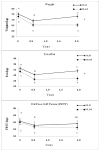Does bone loss begin after weight loss ends? Results 2 years after weight loss or regain in postmenopausal women
- PMID: 24149920
- PMCID: PMC5032655
- DOI: 10.1097/GME.0b013e3182a76fd5
Does bone loss begin after weight loss ends? Results 2 years after weight loss or regain in postmenopausal women
Abstract
Objective: Short-term weight loss is accompanied by bone loss in postmenopausal women. The longer-term impact of weight loss on bone in reduced overweight/obese women compared with women who regained their weight was examined in this study using a case-control design.
Methods: Postmenopausal women (N = 42; mean [SD] body mass index, 28.3 [2.8] kg/m; mean [SD] age, 60.7 [5.5] y) were recruited 2 years after the start of a 6-month weight loss trial; those who maintained their weight (weight loss maintainer [WL-M] group) were matched to a cohort of women who regained their weight (weight loss regainer [WL-R] group). Serum hormones and bone markers were measured in a subset. Bone mineral density (BMD) at the femoral neck, trochanter, spine, radius, and total body, and soft-tissue composition were taken at baseline, 0.5 years, and 2 years.
Results: During weight loss, both groups lost 9.3% (3.4%) of body weight, with no significant difference between the groups. After weight loss, weight change was -0.1% (2.7%) and 6.0% (3.3%) in the WL-M (n = 22) and WL-R (n = 20) groups, respectively. After 2 years, both groups lost BMD at the femoral neck and trochanter (P ≤ 0.01), whereas only the WL-M group reduced BMD at the 1/3 radius (P < 0.001). There was greater BMD loss at the trochanter (-6.8% [5.7%]) and 1/3 radius (-4.5% [3.3%]) in the WL-M group compared with the WL-R group after 2 years. Multiple linear regression showed that change in leg fat mass (but not trunk fat) contributed to trochanter BMD loss (P < 0.05).
Conclusions: After 2 years, there is no BMD recovery of weight reduction-induced bone loss, irrespective of weight regain. These data suggest that the period after weight loss may be an important point in time to prevent bone loss for those who maintain weight and those who regain weight.
Conflict of interest statement
None
Figures



Similar articles
-
Aerobic exercise maintains regional bone mineral density during weight loss in postmenopausal women.J Appl Physiol (1985). 1998 Apr;84(4):1305-10. doi: 10.1152/jappl.1998.84.4.1305. J Appl Physiol (1985). 1998. PMID: 9516197 Clinical Trial.
-
Loss of bone strength in response to exercise-induced weight loss in obese postmenopausal women: results from a pilot study.J Musculoskelet Neuronal Interact. 2014 Jun;14(2):229-38. J Musculoskelet Neuronal Interact. 2014. PMID: 24879027 Free PMC article.
-
Overweight postmenopausal women lose bone with moderate weight reduction and 1 g/day calcium intake.J Bone Miner Res. 2005 Mar;20(3):455-63. doi: 10.1359/JBMR.041132. Epub 2004 Nov 29. J Bone Miner Res. 2005. PMID: 15746990 Free PMC article. Clinical Trial.
-
Addition of aerobic exercise to a weight loss program increases BMD, with an associated reduction in inflammation in overweight postmenopausal women.Calcif Tissue Int. 2009 Apr;84(4):257-65. doi: 10.1007/s00223-009-9232-z. Epub 2009 Mar 11. Calcif Tissue Int. 2009. PMID: 19280097 Free PMC article. Clinical Trial.
-
Relationship between body composition and age, menopause and its effects on bone mineral density at segmental regions in Central Southern Chinese postmenopausal elderly women with and without osteoporosis.Arch Gerontol Geriatr. 2011 Sep-Oct;53(2):e192-7. doi: 10.1016/j.archger.2010.09.002. Epub 2010 Sep 28. Arch Gerontol Geriatr. 2011. PMID: 20880598
Cited by
-
Weight loss and bone mineral density.Curr Opin Endocrinol Diabetes Obes. 2014 Oct;21(5):358-62. doi: 10.1097/MED.0000000000000087. Curr Opin Endocrinol Diabetes Obes. 2014. PMID: 25105997 Free PMC article. Review.
-
Effect of Weight Change Following Intentional Weight Loss on Bone Health in Older Adults with Obesity.Obesity (Silver Spring). 2019 Nov;27(11):1839-1845. doi: 10.1002/oby.22604. Epub 2019 Sep 4. Obesity (Silver Spring). 2019. PMID: 31486297 Free PMC article. Clinical Trial.
-
Role of Calcium and Low-Fat Dairy Foods in Weight-Loss Outcomes Revisited: Results from the Randomized Trial of Effects on Bone and Body Composition in Overweight/Obese Postmenopausal Women.Nutrients. 2019 May 23;11(5):1157. doi: 10.3390/nu11051157. Nutrients. 2019. PMID: 31126121 Free PMC article. Clinical Trial.
-
Effect of Exercise Modality During Weight Loss on Bone Health in Older Adults With Obesity and Cardiovascular Disease or Metabolic Syndrome: A Randomized Controlled Trial.J Bone Miner Res. 2018 Dec;33(12):2140-2149. doi: 10.1002/jbmr.3555. Epub 2018 Aug 7. J Bone Miner Res. 2018. PMID: 30088288 Free PMC article. Clinical Trial.
-
The Effect of Endurance and Endurance-Strength Training on Bone Health and Body Composition in Centrally Obese Women-A Randomised Pilot Trial.Healthcare (Basel). 2022 Apr 28;10(5):821. doi: 10.3390/healthcare10050821. Healthcare (Basel). 2022. PMID: 35627958 Free PMC article.
References
-
- Gozansky WS, Van Pelt RE, Jankowski CM, Schwartz RS, Kohrt WM. Protection of bone mass by estrogens and raloxifene during exercise-induced weight Loss. J Clin Endocrinol Metab. 2005;90:52–59. - PubMed
Publication types
MeSH terms
Grants and funding
LinkOut - more resources
Full Text Sources
Other Literature Sources
Medical

